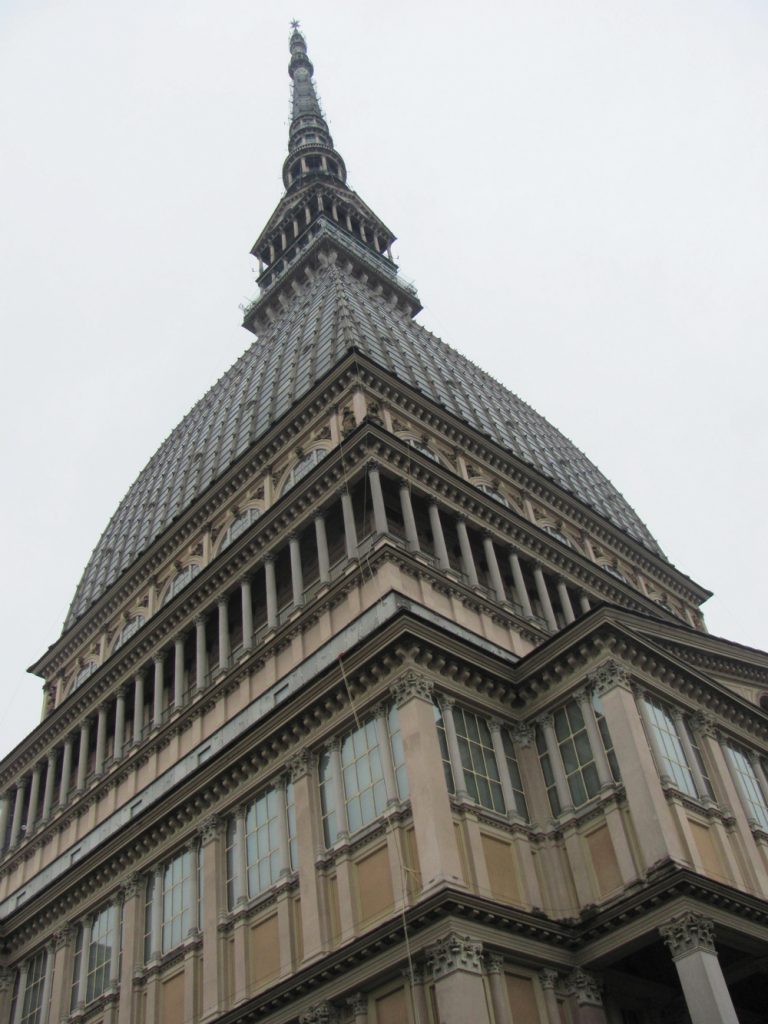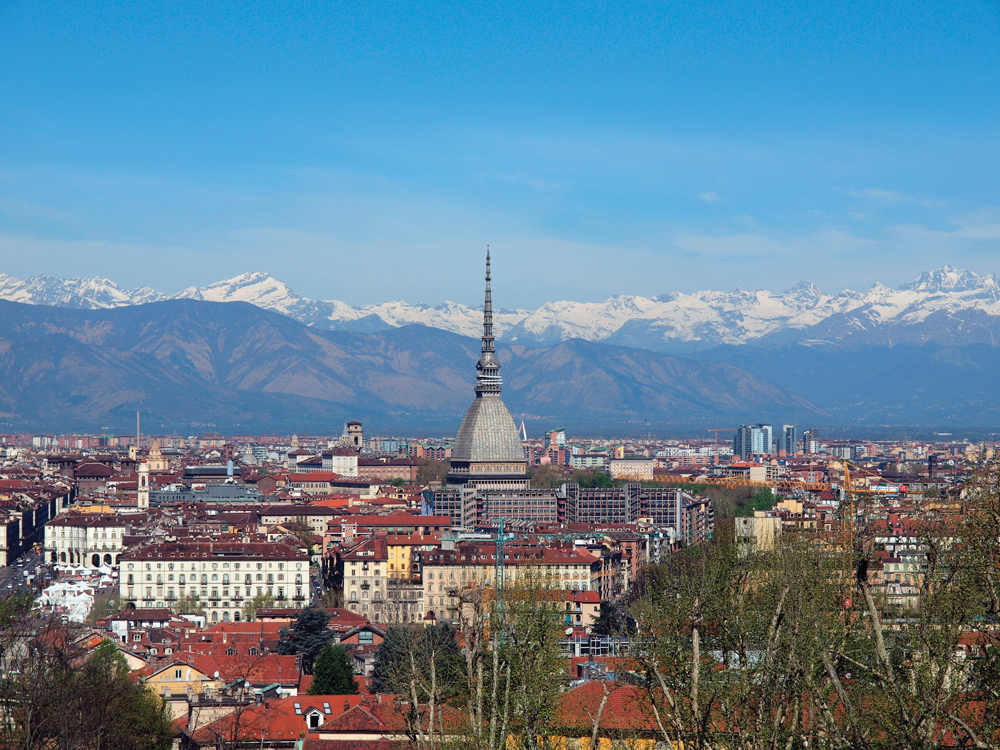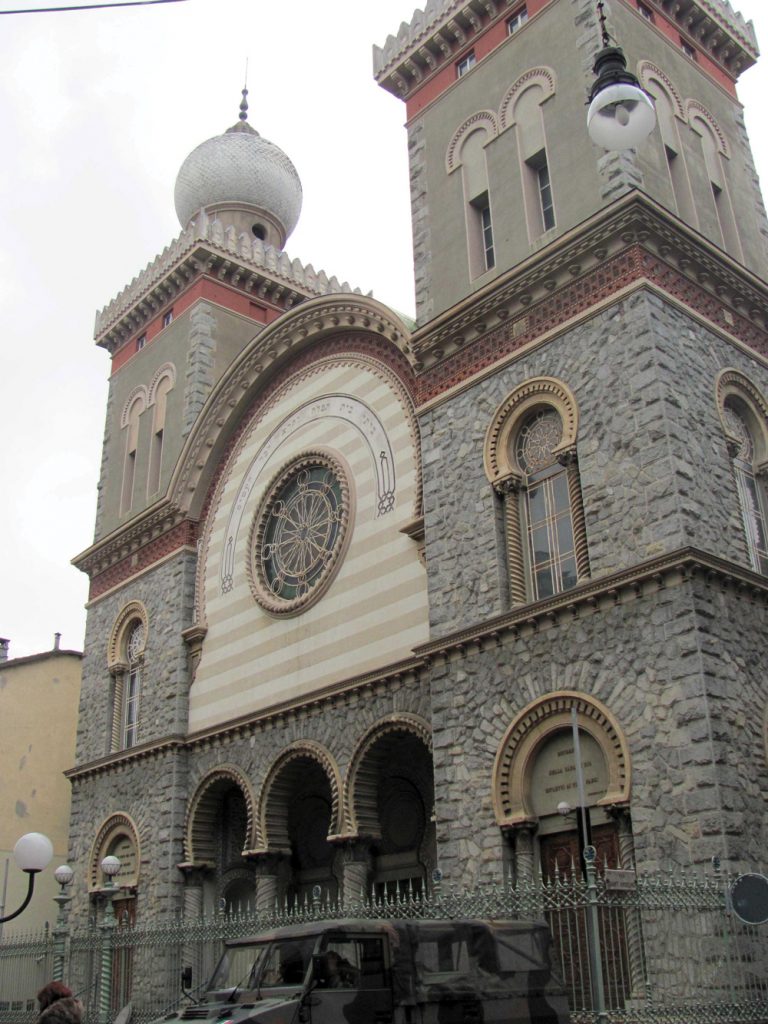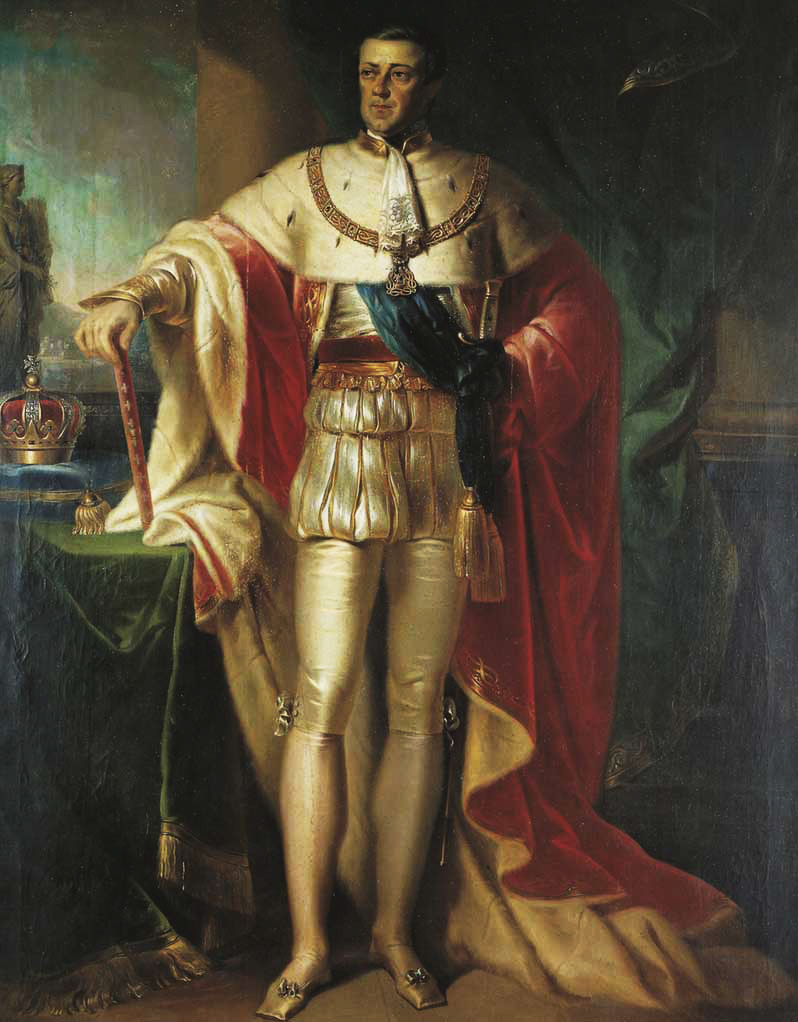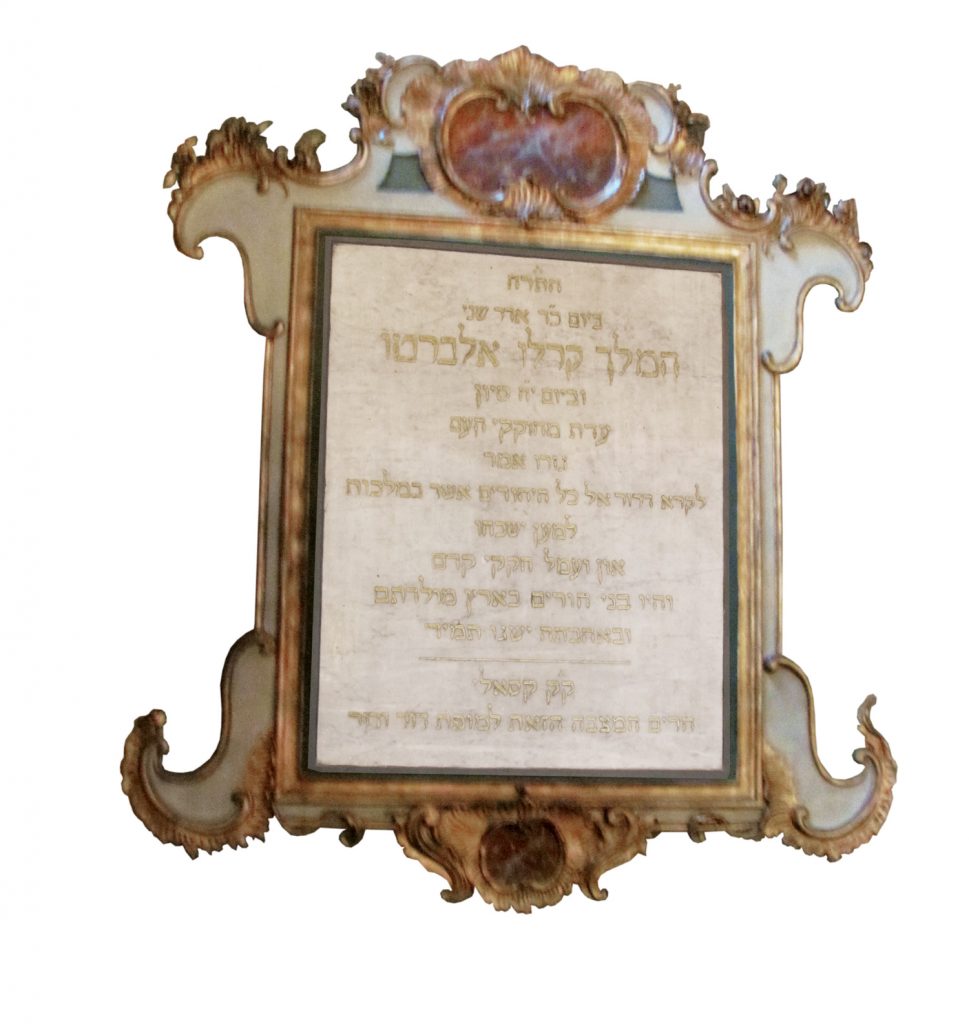Mole Antonelliana
Embossed on the obverse side of the two-cent Italian Euro coin, the Mole Antonelliana is one of the most famous buildings in Europe and the emblem of the city of Turin. Upon completion in 1900, the Mole was the tallest structure in Europe after the Eiffel Tower. There is something undeniably megalomaniac about its design: its spire thrusts from the tangle of surrounding buildings as if determined to make a point, and there is no angle in the immediate vicinity from which one can capture its full height in one glance or camera shot.
The builders of the Mole did indeed have a very definite point to make: when construction began in the 1860s, Turin was the provisional capital of a newly united Italy and the seat of a monarchy riding a wave of romantic patriotism. Rising phoenix-like after centuries as a loose collection of principalities, Italy was just entering the modern world.
Perhaps the most fascinating aspect of the Mole, however, is not the megalomania of architect Alessandro Antonelli – who dragged out the project until he died – but the building’s original purpose: to serve as the flagship synagogue of the capital’s Jewish community. What chutzpa: the Jews, who just a few years previously had still been confined to the cramped ghetto, were occupying the civil heart of the city. And in defiance of the old order, under which no building could be taller than the city’s churches, the Jews’ house of prayer loomed over the entire area. Even today, none of the Gothic cathedrals on the continent come anywhere near the Mole’s 167-meter height (though the Sagrada Família in Barcelona is slated to surpass it).
The Mole never actually functioned as a synagogue. As construction costs spiraled and delays multiplied, Turin was superseded as the capital of Italy by Florence (in 1865) and then, six years later, by Rome. The town’s Jewish population shrank substantially, making the ambitious project superfluous. The community handed the unfinished building over to the Turin municipality in return for a vacant lot on which it erected a far less imposing synagogue, which operates to this day. Meanwhile, the Mole has gone through various incarnations, the most popular of which is probably the current one: the Italian national museum of cinema.
The secret of the Turin Jewish community’s self-confidence lies in the beginning of the modern period, when Italy embarked on unification.
Patriotism Breeds Success
In the first half of the 19th century, Jews could be found in most major cities in northern Italy, crowded into ghettos founded in the 16th and 17th centuries. The Austro-Hungarian Empire controlled Lombardy and Veneto, including Milan, Venice, Padua, and Verona. The pope administered the eastern provinces south of the River Po. Modena and Parma were autonomous principalities. And Piedmont and Liguria – the western area in which Turin and Genoa are situated – belonged to a kingdom that included the island of Sardinia and was originally known as Sardinia-Piedmont. This monarchy was more or less an expanded version of the medieval kingdom of Savoy, or Savoie, an alpine region that encompassed swathes of southwestern Switzerland and is now split between France and Italy.
Turin, an Italian city in the foothills of the Alps. The soaring spire dwarfing the church to its left belongs to the Mole Antonelliana, originally designed as a synagogue
Napoleon’s armies defeated the Piedmontese forces in 1796, giving him dominion over northern Italy; his rule brought the Jews out of the ghettos and, theoretically at least, granted them equal rights. The defeat of Napoleon in 1815 ostensibly restored the old order with all its inherent prejudices, but it was too late. Liberalism and nationalism swept Europe in the 1840s, culminating in the Spring of Nations in 1848. The king of Sardinia-Piedmont, Carlo Alberto (Charles Albert), adopted a constitution granting all his subjects – including the hitherto oppressed Jews and Protestants – equal rights.
Emancipation produced fierce patriotism among the Jews of Piedmont, and their profound exhilaration and gratitude reverberate to this day. An ark originating in the Turin ghetto, now exhibited in the Jewish museum in the basement of the town’s synagogue, was repainted black as a sign of mourning after Carlo Alberto’s death. Several dozen kilometers east of Turin, in the town of Casale Monferrato, two marble plaques flank the ark of the local synagogue. In flowery Italian and Hebrew, they commemorate the constitutional rulings granting the Jews equality. In large, gilded letters, the plaques read:
[In the year] 5608 [1848], on the 24th day of II Adar [March 29], King Carlo Alberto ruled, and on the 18th day of Sivan [June 19] the people’s legislature confirmed, that all Jews in the kingdom shall be liberated, so that their persecution and travail at the hands of previous legislators shall be forgotten, and [the Jews] shall be free people in the land of their birth and prosper in their patriotism. Erected by the holy community of Casale as a monument for posterity.
This was just the beginning of a particularly auspicious relationship between Sardinia-Piedmont and its Jews.
A New Homeland
As the only genuinely Italian kingdom in the country – the rest of Italy was under de facto foreign rule – Alberto’s dominion soon became a focus for those pursuing Italian unification. An enlightened ruler striving to create a constitutional monarchy, the king was hailed as the potential liberator of the Italian people. It was a historic conjunction of the forces of enlightenment and nationalism.
Small wonder, then, that the Jews ranked among the first Italian patriots. Unencumbered by loyalty to the principalities that had discriminated against them, and overwhelmingly grateful to Carlo Alberto for granting them equality, the Italian Jewish community joined forces with the new sovereign to defeat a common enemy – the pope. The would-be synagogue that towered over the local churches symbolized not only religious freedom, but royal defiance of the Vatican’s yoke.
By 1870, in the aftermath of the Franco-Prussian War, the struggle for Italian unity (now under Carlo Alberto’s successor, Victor Emmanuel) had reached the very gates of Rome. Desperate to thwart the territorial ambitions of the nascent Italian state, the pope threatened that anyone laying a hand on the gates of Rome would forfeit his portion in the Church, and therefore in the afterlife. Little did he know that the commander in charge of shelling Porta Pia was a Jew. Captain (later General) Roberto Segre’s forces rushed into the city through the breach their cannon had made by the gate. Heading one of the first infantry units entering Rome was another Jew, Captain Mortara. One of Segre’s descendants was the Israeli Air Force pilot Captain Dan Sigri, killed by Syrian fire on the first day of the Six-Day War.
French – At Least by Origin
Turin’s central role in the Risorgimento (resurgence), or unification of Italy, and its status as the first royal Italian capital sit uneasily with the city’s distinctively West European feel. The vernacular might be Italian, but the Alpine backdrop and elegant boulevards would not be out of place on a Swiss chocolate box. Turin is in fact an internationally acclaimed center of chocolate manufacture, and it hosted the 2006 Winter Olympics. Posters emphasize the city’s place in the European Union, a marketing policy well-suited to the town’s location and esprit.
Although not a large city, Turin has decided flair, if tinged with self-importance. Royal palaces and ornamental gardens, particularly along the River Po, and the most important museum of Egyptian antiquities outside Cairo – a legacy of the 19th century – lend a heritage air. But Turin is also the “T” of Fiat (Fabbrica Italiana Automobili Torino), the Italian carmaker whose factories sprawl over the surrounding industrial area. Its university is renowned, particularly in the fields of medicine, veterinary science, architecture, and design. Sarah Kaminski, whose late husband was one of many Israelis to qualify in veterinary science here, has lived in Turin for years. A lecturer in Hebrew and Hebrew literature at the university, she considers Turin more important than Rome in intellectual terms. A large international book fair reinforces the city’s literary buzz. It was not by chance, Kaminski concludes, that Turin produced two great Italian Jewish writers, Primo Levi and Natalia Ginzburg. “They had little or no connection with the Jewish community,” she points out. “They were grandchildren of the generation that had left the ghetto with the onset of emancipation. Most of that generation kept its distance.” Kaminski, by contrast, sits on the community board.
Not unexpectedly, considering the aforementioned trend, Piedmont’s Jewish communities are disappearing, leaving stunning Baroque-style synagogues and numerous other properties in their wake. Turin boasts virtually the only viable Jewish community, with a functioning synagogue, Jewish educational institutions for all ages, and a seniors’ home – all within one complex. Although very few local Jews are strict Sabbath-observers, many attend services on Saturday mornings, and the community is relatively active. Many families have lived in Turin for centuries and are proud to preserve their ancient tradition. Jews apparently arrived in this area in the 13th century, after expulsions from France and Germany.
“Legend has it that some of the Jews of Turin were fugitives from Spain,” explains Marco Luzzati, a Turin businessman in his fifties and an armchair genealogist who could put professionals to shame. “Take the Segre family, for example – the family of the officer from Turin who was in charge of the shelling of Rome. They had assumed that their name derived from a river in Spain, and that their origins were in that vicinity. However, I found the name in ancient documents long predating the Spanish expulsion. It turns out that Segre, like the other ancient family names in this community, is originally French. You find Spanish names in Tuscany and Livorno, for instance, but very few Jews from Spain appear to have made their way here.
“Most Jews in Turin evidently came via France,” Luzzati adds. “The Trier family, for example, came from Troyes, home of the famous commentator Rashi (Rabbi Solomon Itzhaki, 1040–1105). All the local families we’ve researched whose names are linked to towns show that this community is composed of medieval Jews expelled from France.”
While the legacy of Rashi and his fellow commentators the Tosaphists remains a fundamental part of Jewish Bible and Talmud study, their way of life and even their liturgy have practically vanished from Jewish history. Except in Piedmont. The text of the prayer book used here – combining elements from ancient Germany, Provence, and France – is known as “Apam,” an acronym of three Piedmont communities: Asti, which still boasts a tiny Jewish presence; Fasano; and Moncalvo.
Conservative Assimilation
Turin’s Jewish community is highly conservative. Its determination to preserve the legacy of seven hundred years of local Jewish life has produced some interesting anomalies in what is, generally speaking, not a particularly observant community. The synagogue is run according to the letter of rabbinical law, with local customs kept so painstakingly that only prayer books published by the community in strict accordance with Turin tradition are allowed. The Sabbath melodies sung here are unique, their pleasant musicality echoing neither Ashkenazic cantoral operatics nor traditional Sephardic cantillation.
Much effort is invested in preserving the community’s identity and treasures. A well-equipped library adjoining the synagogue holds a surprising number of books about Judaism and Israel, all in Italian. The antique Hebrew book collection, safe behind glass, is equally impressive. The Jewish center in Turin also oversees the preservation of other synagogues in Piedmont, most of which now serve mainly as museums.
In the midst of all this tradition, assimilation abounds and intermarriage is rife. Judaism is perceived more as a family heritage and a topic for study and discussion than an obligation. Rabbi Eliyahu Birnbaum, head of the Straus-Amiel rabbinical seminary, is currently serving in Turin as an interim rabbi. The community prefers in-depth classes in Jewish law to philosophizing sermons, he says. In Turin, halakhic studies are part of Jewish intellectual life. Practical commitment is something else.
Turin’s Jewish community has about nine hundred registered members. In its prime – when the Mole was being built – it numbered some two thousand. Back then, Jews flocked to Turin, drawn to its university and urban opportunities. But difficult days followed. Racial laws introduced by Mussolini’s Fascist regime in 1938 induced many Jews to convert or emigrate, and around four hundred were deported to German concentration camps. Those who had left or converted were not tempted to return when circumstances eased. Yet today, here and there in Turin, elderly people show interest in the Judaism they abandoned or never knew. They find themselves becoming part of a community actively carrying its ancient legacy into the 21st century.
The plaque in the Casale synagogue on which the Jews expressed their eternal gratitude to the king

